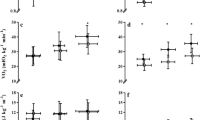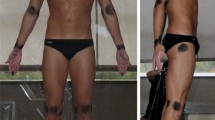Abstract
The aim of this study was to investigate the interplay between the arm stroke efficiency (an index of propelling efficiency, η P) and the static and dynamic position in water (indexes of hydrodynamic resistance, W d) in determining the energy cost of front crawl (C) during a swimmer’s growth. These three parameters are indeed related by the following equation: \( C = W_{{\text{d}}} /(\eta _{{\text{P}}} \cdot\eta _{{\text{o}}} ) \) where η o is the overall efficiency of swimming. The experiments were carried out on 72 swimmers (38 M and 34 F; 8–19 years) who were asked to swim at 1 m s−1. The static position in water was assessed by measuring the underwater torque (T′); the dynamic position in water by measuring the projected frontal area (A eff). The ratio between the average values of the eldest to youngest class of age was 3.84 and 2.27 for T′, 2.13 and 1.68 for A eff, and 1.13 and 1.24 for η P (in M and F, respectively). The increase in T′ and in A eff was larger than the increase in efficiency suggesting that, in this age range, C should increase, the more so in M than F. Indeed, C increased by 1.58 in male and 1.17 in female swimmers. Based on the values of C and η P (and assuming a constant value of η o) it is possible to estimate that, in this age range, W d increases by about 1.97 in male and 1.32 in female swimmers, an increase which is proportional to the observed increase in A eff.





Similar content being viewed by others
References
Alexander R McN (1983) Motion in fluids. In: Animal mechanics. Blackwell Scientific Publications, Oxford, pp 183–233
Capelli C, Zamparo P, Cigalotto A, Francescato MP, Soule RG, Termin B, Pendergast DR, di Prampero PE (1995) Bioenergetics and biomechanics of front crawl swimming. J Appl Physiol 78:674–679
Chatard JC, Bourgoin B, Lacour JR (1990a) Passive drag is still a good evaluator of swimming aptitude. Eur J Appl Physiol 59:399–404
Chatard JC, Lavoie JM, Lacour JR (1990b) Analysis of determinants of swimming economy in front crawl. Eur J Appl Physiol 61:88–92
Chatard JC, Lavoie JM, Lacour JR (1991) Energy cost of front crawl swimming in women. Eur J Appl Physiol 63:12–16
Clarys JP (1979) Human morphology and hydrodynamics. In: Terauds J, Bedingfield EW (eds) Swimming III. University Park Press, Baltimore, pp 3–41
Costill DL, Kovalesky J, Porter D, Kirwan J, Fielding R, King D (1985) Energy expenditure during front crawl swimming: predicting success in middle distance events. Int J Sport Med 6:266–270
Deshodt VJ, Arsac LM, Rouard AH (1999) Relative contribution of arms and legs in humans to propulsion in 25 m sprint front crawl swimming. Eur J Appl Physiol 80:192–199
di Prampero PE (1986) The energy cost of human locomotion on land and in water. Int J Sports Med 7:55–72
Haycock GB, Schwartz GJ, Wisotsky DH (1978) Geometric method for measuring body surface area: a height weight formula validated in infants, children and adults. J Pediatr 93:62–66
Hollander AP, De Groot G, Van Ingen Schenau GJ, Kahman R, Toussaint HM (1988) Contribution of the legs to propulsion in front crawl swimming. In: Ungherects BE, Wilkie K, Reischle K (eds) Swimming Science V. Human Kinetics, Champaign, pp 39–43
Kjendlie PL, Stallman RK, Gunderson JS (2004a) Passive and active floating torque during swimming. Eur J Appl Physiol 93:75–81
Kjendlie PL, Stallman RK, Gunderson JS (2004b) Adults have lower stroke rate during sub maximal front crawl swimming than children. Eur J Appl Physiol 91:649–655
Kjendlie PL, Ingjer F, Madsen O, Stallman RK, Gunderson JS (2004c) Differences in the energy cost between children and adults during front crawl swimming. Eur J Appl Physiol 91:473–480
Kjendlie PL, Stallman RK (2008) Drag characteristics of competitive swimming children and adults. J Appl Biomech 24:35–42
Lavoie JM, Montpetit R (1986) Applied physiology of swimming. Sports Med 165:165–189
Lohman TG (1989) Assessment of body composition in children. Pediatr Exerc Sci 1:19–30
McArdle WD, Katch FI, Katch VL (2007) Measurement of human energy expenditure. In: Exercise physiology; energy, nutrition and human performance. Lippincott, Philadelphia, pp 183−194
Montpetit R, Leger L, Lavoie JM, Cazorla G (1981) VO2 peak during free swimming using the backward extrapolation of the recovery curve. Eur J Appl Physiol 47:385–391
Montpetit R, Lavoie JM, Cazorla G (1983) Aerobic energy cost of swimming the front crawl at high speed in international class and adolescent swimmers. In: Hollander PA, Huijing PA, de Groot G (eds) Biomechanics and medicine in swimming. Human Kinetics, Champaign, pp 228–234
Montpetit R, Cazorla G, Lavoie JM (1988) Energy expenditure during front crawl swimming: a comparison between males and females. In: Ungherects BE, Wilkie K, Reischle K (eds) Swimming science V. Human Kinetics, Champaign, pp 229–236
Mollendorf JC, Termin AC, Oppenheim E, Pendergast DR (2004) Effect of swim suit design on passive drag. Med Sci Sports Exerc 36:1029–1035
Pendergast DR, di Prampero PE, Craig AB, Wilson D, Rennie W (1977) Quantitative analysis of front crawl in men and women. J Appl Physiol 43:475–479
Pendergast DR, Zamparo P, di Prampero PE, Mollendorf J, Capelli C, Cerretelli C, Termin A, Craig A, Bushnell D, Paschke D (2003) Energy balance of human locomotion in water. Eur J Appl Physiol 90:377–386
Pendergast DR, Mollendorf J, Zamparo P, Termin A, Bushnell D, Paschke D (2005) The influence of drag on human locomotion in water. Undersea Hyperb Med 32:45–57
Pelayo P, Wille F, Sidney M, Berthoin S, Lavoie JM (1997) Swimming performance and stroking parameters in non skilled grammar pupils: relation with age, gender and some anthropometric characteristics. J Sports Med Phys Fitness 37:187–193
Poujade B, Hautier CA, Rouard A (2002) Determinants of the energy cost of front crawl swimming in children. Eur J Appl Physiol 87:1–6
Rowland TW (1996) Developmental exercise physiology. Human kinetics, Champaign
Slaugther MH, Lohman TG, Boileau RA, Horswill CA, Stillman RH, Van Loan MD, Bemben DA (1988) Skinfold equations for estimation of body fatness in children and youth. Hum Biol 60:709–723
Toussaint HM (1990) Differences in propelling efficiency between competitive and triathlon swimmers. Med Sci Sports Exerc 22:409–415
Toussaint HM, de Looze M, van Rossem B, Leijdekkers M, Dignum H (1990) The effect of growth on drag in young swimmers. Int J Biomech 6:18–28
Toussaint HM, Janssen T, Kluft M (1991) Effect of propelling surface size on the mechanics and energetics of front crawl swimming. J Biomech 24:205–211
Toussaint HM, Beek PJ (1992) Biomechanics of competitive front crawl swimming. Sports Med 13:8–24
Toussaint HM, Roos PE, Kolmogorov S (2004) The determination of drag in front crawl swimming. J Biomech 37(11):1655–1663
Van Tilborg L, Daly D, Persyn U (1982) The influence of some somatic factors on passive drag, gravity and buoyancy forces in competitive swimmers. In: Hollander PA, Huijing PA, de Groot G (eds) Biomechanics and medicine in swimming. Human Kinetics, Champaign, pp 207–214
Vorontsov A, Rumyanstev VA (2000) Resistive forces in swimming. In: Zatsiorsky VM (ed) Biomechanics in sport: performance enhancement and injury prevention. Blackwell, Oxford, pp 184–204
Vorontsov A, Binevsky D (2003) Swimming speed, stroke rate and stroke length during maximal 100 m free style of boys 11–16 years of age. In: Chatard JC (ed) Biomechanics and medicine in swimming IX. Publications de l’Université de Saint Etienne, Saint Etienne, pp 195–200
Wilson B, Thorp R (2003) Active drag in swimming. In: Chatard JC (ed) Biomechanics and medicine in swimming IX. Publications de l’Université de Saint Etienne, Saint Etienne, pp 15–20
Yanai T (2001) Rotational effect of buoyancy in front crawl: does it really cause the legs to sink? J Biomech 34:235–243
Zamparo P, Capelli C, Termin B, Pendergast DR, di Prampero PE (1996a) Effects of the underwater torque on the energy cost, drag and efficiency of front crawl swimming. Eur J Appl Physiol 73:195–201
Zamparo P, Antonutto G, Capelli C, Francescato MP, Girardis M, Sangoi R, Soule RG, Pendergast DR (1996b) Effects of body size, body density, gender and growth on underwater torque. Scand J Med Sci Sports 6:273–280
Zamparo P, Capelli C, Cautero M, Di Nino A (2000) Energy cost of front crawl swimming at supra maximal speeds and underwater torque in young swimmers. Eur J Appl Physiol 83:487–491
Zamparo P, Pendergast DR, Termin B, Minetti AE (2002) How fins affect the economy and efficiency of human swimming. J Exp Biol 205:2665–2676
Zamparo P, Pendergast DR, Mollendorf J, Termin B, Minetti AM (2005) An energy balance of front crawl. Eur J Appl Physiol 94:134–144
Zamparo P (2006) Effects of age and gender on the propelling efficiency of the arm stroke. Eur J Appl Physiol 97:52–58
Acknowledgments
We would like to thank all the swimmers and their coaches for their patience and kind cooperation, and we are grateful to Prof. P. E. di Prampero for his useful suggestions in revising the manuscript.
Author information
Authors and Affiliations
Corresponding author
Rights and permissions
About this article
Cite this article
Zamparo, P., Lazzer, S., Antoniazzi, C. et al. The interplay between propelling efficiency, hydrodynamic position and energy cost of front crawl in 8 to 19-year-old swimmers. Eur J Appl Physiol 104, 689–699 (2008). https://doi.org/10.1007/s00421-008-0822-7
Accepted:
Published:
Issue Date:
DOI: https://doi.org/10.1007/s00421-008-0822-7




